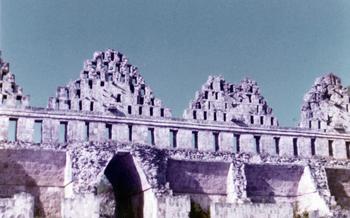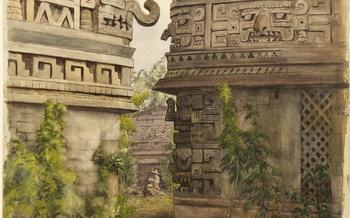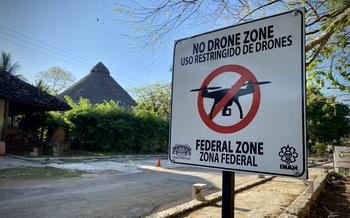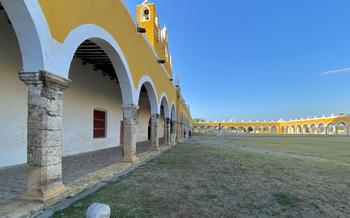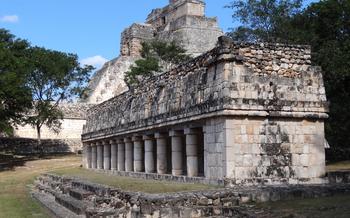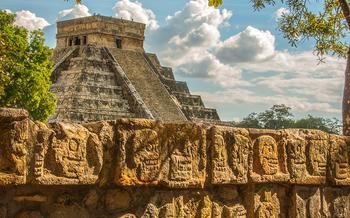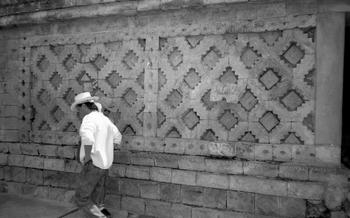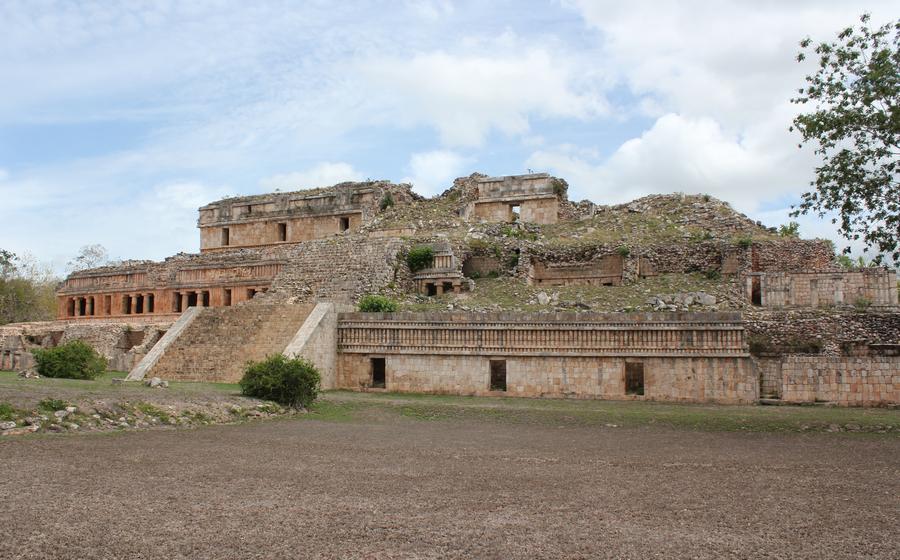
Sayil Archaeological Site
- Uxmal: A Majestic Mayan City in the Yucatan Peninsula
- Exploring the Ruins of Sayil: A Journey Through Time
- The Temple of the Masks: Unveiling the Mysteries
- The Quadrangle of the Nuns: A Place of Rituals and Ceremonies
- The Juego de Pelota: A Thrilling Mayan Sport
- The Cenote Xlacah: A Natural Wonder in the Heart of Uxmal
- Sayil's Lesser-Known Gems: Unveiling Hidden Treasures
- Tips for an Enriching Visit to Sayil
- Transportation Options to Reach Sayil
- Guided Tours vs. Self-Exploration: Making the Right Choice
- Accommodation Options Near Sayil
- Local Cuisine and Dining Experiences
- Additional Activities in the Uxmal Region
- Insider Tip: Uncrowded Exploration and Photography
Uxmal: A Majestic Mayan City in the Yucatan Peninsula
Uxmal, a UNESCO World Heritage Site, is an ancient Mayan city located in the southern part of Mexico's Yucatan Peninsula. It is a place of remarkable historical significance, boasting well-preserved ruins that offer a glimpse into the lives and culture of the ancient Maya civilization.
Location and accessibility: Uxmal is easily accessible from the city of Merida, the capital of Yucatan. It is situated approximately 62 miles (100 kilometers) south of Merida and can be reached by car or bus in about 5 to 2 hours.
Best time to visit: The best time to visit Uxmal is during the dry season, which runs from November to April. During this time, the weather is pleasant and dry, making it ideal for exploring the ruins.
Practical information: Before visiting Uxmal, remember to wear comfortable shoes as you'll be doing a lot of walking. Also, bring sunscreen, a hat, and plenty of water to stay hydrated in the tropical heat. The site has a small museum where you can learn more about the history and culture of the Maya.
Exploring the Ruins of Sayil: A Journey Through Time
Located just 5 kilometers from the main ruins of Uxmal, Sayil is an ancient Maya city that offers a glimpse into the region's rich history and culture. Once a bustling metropolis, Sayil's ruins transport visitors back in time, showcasing intricate architecture, symbolic structures, and a captivating story.
Sayil's significance lies in its role as a ceremonial and administrative center during the Classic period (250-900 AD). The city's strategic location along trade routes contributed to its prosperity, resulting in the construction of impressive buildings, plazas, and temples.
As you explore the ruins, you'll encounter notable structures such as the Grand Palace, the Temple of the Masks, and the Quadrangle of the Nuns. Each building showcases unique architectural features, including intricate carvings, colorful murals, and imposing facades.
Conservation efforts are ongoing to preserve Sayil's heritage. Archaeological excavations have uncovered valuable artifacts and provided insights into the city's past. However, challenges remain in balancing preservation with the need to make the site accessible to visitors while protecting its integrity.
The Temple of the Masks: Unveiling the Mysteries
Amidst the ruins of Sayil, the Temple of the Masks stands as a testament to the artistic prowess and religious beliefs of the ancient Maya. Its façade is adorned with a series of grotesque masks, each carved from a single block of stone and representing different deities or supernatural beings. These masks are believed to have served as guardians of the temple, protecting the sacred space within from evil spirits.
The temple's architectural style is characterized by its corbelled arch, a technique in which stones are stacked horizontally with each layer slightly overlapping the one below, creating a self-supporting arch. This technique allowed the Maya to construct large and imposing structures without the use of mortar or cement.
The interior of the temple is relatively small and dark, with a single chamber that was likely used for religious rituals and ceremonies. The walls are adorned with intricate carvings and bas-reliefs depicting various scenes from Mayan mythology. These carvings provide valuable insights into the beliefs and practices of the ancient Maya.
Today, the Temple of the Masks remains one of the most iconic and well-preserved structures at Sayil. It stands as a testament to the skill and artistry of the Maya and continues to captivate visitors with its enigmatic masks and aura of mystery. Ongoing research and excavations at the site are shedding new light on the significance of this temple and its role in the ancient Maya world.
The Quadrangle of the Nuns: A Place of Rituals and Ceremonies
The Quadrangle of the Nuns, also known as the House of the Turtles, is a significant architectural complex within the Sayil archaeological site. It consists of a rectangular courtyard surrounded by several structures, including small rooms, platforms, and altars. The quadrangle derives its name from the numerous turtle motifs found in its decorations, which hold symbolic and religious significance in Mayan culture.
This sacred space was likely used for various religious ceremonies, rituals, and gatherings. Archaeologists believe it served as a place of worship, meditation, and spiritual connection for the community. Evidence suggests that the quadrangle was also used for astronomical observations, as some of the structures are aligned with celestial events.
During excavations, archaeologists discovered several artifacts within the quadrangle, including ceramic vessels, stone tools, and jewelry. These findings provide valuable insights into the daily life and rituals performed by the ancient Maya inhabitants of Sayil.
Presently, the Quadrangle of the Nuns is in a relatively well-preserved state, allowing visitors to appreciate its architectural features and decorations. Ongoing excavations and research continue to shed light on the significance and use of this sacred space, providing a glimpse into the religious and cultural practices of the ancient Maya civilization.
The Juego de Pelota: A Thrilling Mayan Sport
Amidst the awe-inspiring structures of Sayil lies an intriguing vestige of ancient Mayan culture—the Juego de Pelota, or ball court. This rectangular arena, with its sloping sides and stone rings embedded in the walls, served as the stage for a captivating sport that held deep cultural and mythological significance.
The rules of the game, known as Pok-ta-Pok, are shrouded in mystery, but it is believed to have involved two teams competing to propel a rubber ball through the stone rings using only their hips, elbows, and knees. The game was not merely a form of entertainment but also a ritual deeply intertwined with Mayan cosmology and mythology.
The ball court at Sayil is one of the best-preserved examples of this ancient sport. Its strategic location suggests that it was a significant gathering place for the community, where fierce competitions took place and spectators cheered on their favored teams. The site exudes an air of mystery and intrigue, inviting visitors to imagine the excitement and energy that once filled this sacred space.
Today, the Juego de Pelota stands as a testament to the Mayans' ingenuity, athleticism, and spiritual beliefs. Exploring this ancient arena allows us to connect with the past and gain a deeper understanding of the rich cultural heritage of Mexico's Mayan civilization.
The Cenote Xlacah: A Natural Wonder in the Heart of Uxmal
Nestled within the lush vegetation of Uxmal, the Cenote Xlacah stands as a testament to the region's natural beauty. This subterranean marvel, with its refreshing turquoise waters and awe-inspiring stalactite formations, offers a welcome respite from the sun-drenched ruins. Discover the geological wonders of cenotes, formed by the collapse of limestone bedrock, and immerse yourself in the local legends that surround this sacred site.
To reach the cenote, follow a short path that leads you through the verdant jungle, providing glimpses of exotic wildlife and native flora. As you descend into the cenote's depths, the air becomes cooler and the sound of dripping water fills the air. A wooden platform extends over the cenote, offering a safe and picturesque spot to admire its crystal-clear waters and towering walls.
Take a moment to soak in the tranquility of the cenote, letting the gentle sounds of nature wash away your worries. Observe the intricate stalactites that hang from the ceiling, each one a unique masterpiece sculpted by the relentless flow of water. The cenote's refreshing waters invite you to take a dip and experience the invigorating embrace of nature.
For those seeking a truly immersive experience, consider snorkeling or diving in the cenote's depths. Explore the underwater world, home to a variety of aquatic creatures, and marvel at the stunning rock formations that create a surreal underwater landscape.
Remember to respect the sanctity of the cenote by refraining from using any harmful chemicals or leaving any trace of your visit behind. Embrace the opportunity to connect with nature and create lasting memories in this magical underground oasis.
Sayil's Lesser-Known Gems: Unveiling Hidden Treasures
Beyond the main ruins of Sayil, there are several lesser-known structures that offer a glimpse into the site's rich history and diverse architecture. These hidden gems are often overlooked by visitors who rush to see the more famous attractions, but they hold their own unique significance and charm.
One such structure is the Temple of the Dwarf, a small but intricately decorated temple located on the outskirts of the site. The temple is named for its unusual sculptures, which depict figures with short stature and exaggerated features. It is believed that these figures represent dwarfs or hunchbacks, who held a special place in Mayan society and were often associated with humor and entertainment.
Another hidden gem is the Palace of the Governors, a large and imposing structure that served as the administrative center of Sayil. The palace features a series of rooms and courtyards, each with its own unique purpose. The walls are adorned with intricate carvings and paintings, which depict scenes from Mayan mythology and history.
Finally, the Quadrangle of the Columns is a unique and impressive structure that consists of a large courtyard surrounded by a series of columns. The columns are topped with carved stone capitals, which depict a variety of human and animal figures. The purpose of this quadrangle is not fully understood, but it is believed to have been used for religious or ceremonial purposes.
These lesser-known structures provide a fascinating glimpse into the diversity and complexity of Sayil. They offer visitors a chance to explore beyond the main ruins and discover the hidden treasures that this ancient city has to offer.
Tips for an Enriching Visit to Sayil
To make the most of your visit to Sayil, here are a few tips to ensure a rewarding and enjoyable experience:
-
Plan for a Duration of 2-3 Hours: Allow yourself ample time to explore the main ruins and uncover the hidden gems of Sayil. This duration will enable you to appreciate the site's grandeur, capture captivating photos, and immerse yourself in the history and culture of this ancient Mayan city.
-
Essentials for a Comfortable Visit: Remember to bring comfortable footwear, as you'll be doing a lot of walking on uneven terrain. Sun protection is crucial, so carry a hat, sunglasses, and sunscreen. Water is essential, especially during the hot and humid Yucatan weather. Consider bringing snacks or a packed lunch, as there are limited food options available at the site.
-
Respect and Etiquette: Remember that Sayil is an ancient archaeological site, so it's essential to treat it with respect and care. Avoid touching or climbing on the ruins, as this can damage them. Stay on designated paths and be mindful of your surroundings, especially near fragile structures.
-
Capture the Light: For photography enthusiasts, the best time to visit Sayil is either early in the morning or late in the afternoon. The soft, warm light during these times enhances the colors and textures of the ruins, creating stunning photographic opportunities.
Transportation Options to Reach Sayil
Reaching Sayil from Uxmal involves a short but scenic journey. Several transportation options cater to different preferences and budgets, offering a convenient and hassle-free travel experience.
Option 1: Organized Tours
Many tour operators in Uxmal offer organized group tours to Sayil. These tours typically include round-trip transportation, a guided tour of the ruins, and sometimes even a visit to other nearby attractions.
Pros:
- Convenience of having everything arranged, including transportation and a guide.
- Informative commentary from a knowledgeable guide who can provide historical context and insights.
Cons:
- Limited flexibility in terms of departure times and duration of stay at the site.
- Higher cost compared to other options.
Option 2: Taxis or Rental Cars
For those who prefer more independence and flexibility, taxis and rental cars are readily available in Uxmal. The drive to Sayil takes approximately 30 minutes, and you can set your own pace and explore the ruins at your leisure.
Pros:
- Freedom to customize your itinerary and spend as much time as you want at the site.
- Flexibility to make additional stops along the way or visit other nearby attractions.
- Lower cost compared to organized tours.
Cons:
- Need to arrange for transportation back to Uxmal, which may require some coordination.
- Requires basic navigation skills and familiarity with the roads.
Option 3: Public Transportation
For budget-conscious travelers, public transportation is a viable option to reach Sayil. Local buses depart from Uxmal's bus station and drop off passengers at the entrance to the archaeological site.
Pros:
- Most economical option, especially for solo travelers.
- Offers a glimpse into the local way of life and an opportunity to interact with locals.
Cons:
- Buses may be crowded and uncomfortable, especially during peak tourist season.
- Less frequent departures compared to taxis or rental cars.
- Limited flexibility in terms of departure times and duration of stay at the site.
Insider Tip:
Consider renting a bicycle for an eco-friendly and immersive way to explore the Uxmal region. Several bike rental shops in Uxmal offer mountain bikes suitable for navigating the countryside trails.
Guided Tours vs. Self-Exploration: Making the Right Choice
Whether to embark on a guided tour or explore Sayil independently is a matter of personal preference and travel style. Guided tours offer the advantage of expert insights and historical context, allowing you to delve deeper into the significance of the ruins. Experienced guides can provide detailed explanations of the structures, their functions, and the cultural context of the ancient Maya civilization. Guided tours typically follow a structured itinerary, ensuring that you cover all the important highlights of the site.
On the other hand, self-exploration provides the freedom to wander at your own pace, soak in the atmosphere, and explore areas that particularly capture your interest. You can linger longer at specific structures, take your time to photograph the intricate details, and enjoy the tranquility of the site without the constraints of a group itinerary. Self-exploration allows for a more personal and intimate connection with the ruins, enabling you to immerse yourself in the ancient world at your own rhythm.
Ultimately, the choice between a guided tour and self-exploration depends on your preferences, budget, and time constraints. If you seek in-depth knowledge and historical insights, a guided tour is highly recommended. However, if you prefer the flexibility and freedom to explore at your own pace, self-exploration is an excellent option.
Accommodation Options Near Sayil
When planning your visit to Sayil, finding suitable accommodation near the archaeological site is essential for a comfortable and enjoyable experience. While there are no hotels or guesthouses directly within the Sayil ruins, the nearby town of Uxmal offers a range of accommodation options to suit different preferences and budgets.
Hotels and Resorts:
For a luxurious and convenient stay, several hotels and resorts are located within a short distance of Uxmal. These establishments offer amenities such as swimming pools, restaurants, and tour desks, providing a comfortable base for exploring the region.
Budget Accommodations:
For travelers on a tighter budget, budget hotels and hostels are available in Uxmal, offering basic yet comfortable accommodations. These options are ideal for those seeking a more affordable stay without compromising on convenience.
Vacation Rentals:
For a more immersive experience, consider renting a vacation home or apartment in Uxmal. This option provides the privacy and flexibility of having your own space, allowing you to cook meals and enjoy the local atmosphere.
When selecting your accommodation, consider factors such as proximity to the ruins, amenities, and budget. Booking in advance, especially during peak tourist season, is advisable to secure your preferred choice.
Local Cuisine and Dining Experiences
Uxmal offers a delightful culinary adventure, where you can savor the flavors of traditional Yucatecan cuisine. One must-try is cochinita pibil, a slow-roasted pork dish infused with achiote paste and wrapped in banana leaves. Panuchos, another local delicacy, consists of fried tortillas topped with refried beans, shredded turkey, and pickled red onions. For a refreshing treat, try agua de lima, a zesty lime-flavored drink.
Venturing into the local markets is a great way to experience the authentic flavors of Uxmal. Here, you can find fresh produce, homemade tortillas, and a variety of regional specialties. Don't miss the chance to sample the local street food, such as freshly made tacos and tamales.
For a memorable dining experience, visit one of the restaurants near the ruins. These establishments often offer traditional Mayan dishes alongside international cuisine, providing a delightful fusion of flavors. Be sure to ask for recommendations on local specialties and accompany your meal with a refreshing agua fresca or a cold cerveza.
As you indulge in the culinary delights of Uxmal, remember that Mayan cuisine is not just about taste but also about cultural heritage. Each dish tells a story, representing the region's rich history and traditions. So, embrace the opportunity to savor the local flavors and gain a deeper appreciation for the vibrant culture of Uxmal.
Additional Activities in the Uxmal Region
Beyond Sayil, the Uxmal region offers a wealth of other attractions for travelers to explore. For those with a passion for history and archaeology, nearby archaeological sites such as Kabah, Labná, and Xlapak are worth visiting. Each of these sites boasts unique architectural features and offers a glimpse into the rich cultural heritage of the region.
Nature enthusiasts will find plenty to appreciate as well. The Uxmal region is home to several cenotes, natural sinkholes filled with crystal-clear water. These cenotes provide a refreshing retreat from the tropical heat and offer opportunities for swimming, snorkeling, and diving.
For those interested in learning more about Mayan culture, there are several opportunities to engage with local communities and artisans. Visitors can participate in workshops to learn traditional crafts such as weaving, pottery, and woodcarving. These experiences offer a deeper understanding of the region's cultural traditions and provide a chance to support local artisans.
For those with time to spare, consider extending your stay in the Uxmal region and embarking on a multi-day itinerary. This will allow you to explore the region's attractions at a leisurely pace and delve deeper into its history and culture. There are several tour operators that offer guided multi-day trips, or you can plan your own itinerary and rent a car or hire a private driver.
Insider Tip: Uncrowded Exploration and Photography
For a serene and crowd-free experience at Sayil, plan your visit during the early morning hours before the tour groups arrive. This will allow you to immerse yourself in the tranquility of the ancient ruins and capture stunning photographs without distractions. As the sun rises, the soft golden light casts a magical glow on the structures, creating an ideal backdrop for capturing the essence of Sayil.
When exploring the site, venture beyond the main attractions to discover hidden corners and lesser-known structures. These secluded spots often offer unique perspectives and opportunities for capturing captivating images. Be respectful of the site's integrity and refrain from climbing or touching the ruins. Instead, use your camera lens to document the intricate carvings and architectural details from a respectful distance.
Remember to bring a sturdy tripod to ensure sharp and steady shots, especially in low-light conditions. Experiment with different angles and compositions to create dynamic and visually appealing photographs. Capture the grand scale of the structures by including the surrounding landscape, and don't forget to look for details such as intricate carvings, sculptures, and hieroglyphs that tell the story of Sayil's rich history.

